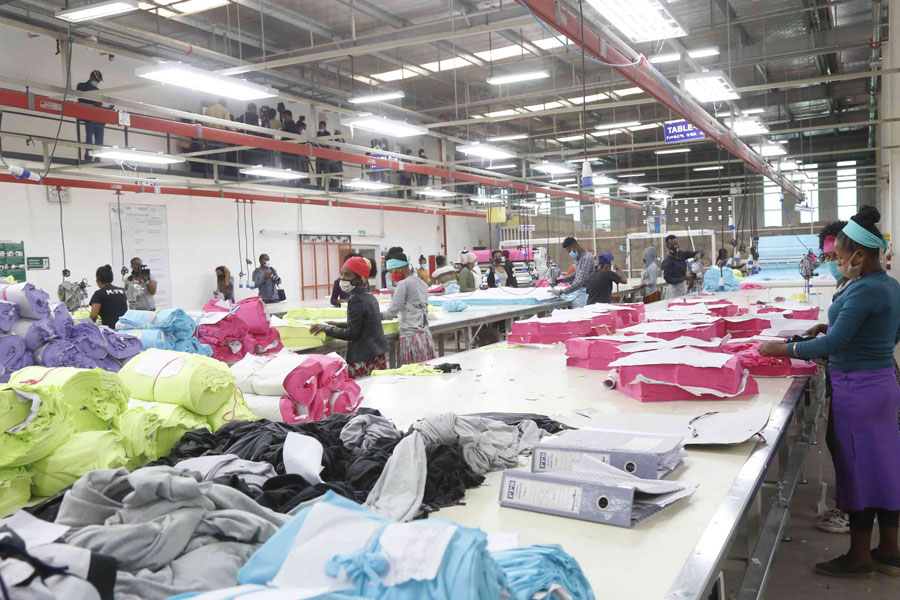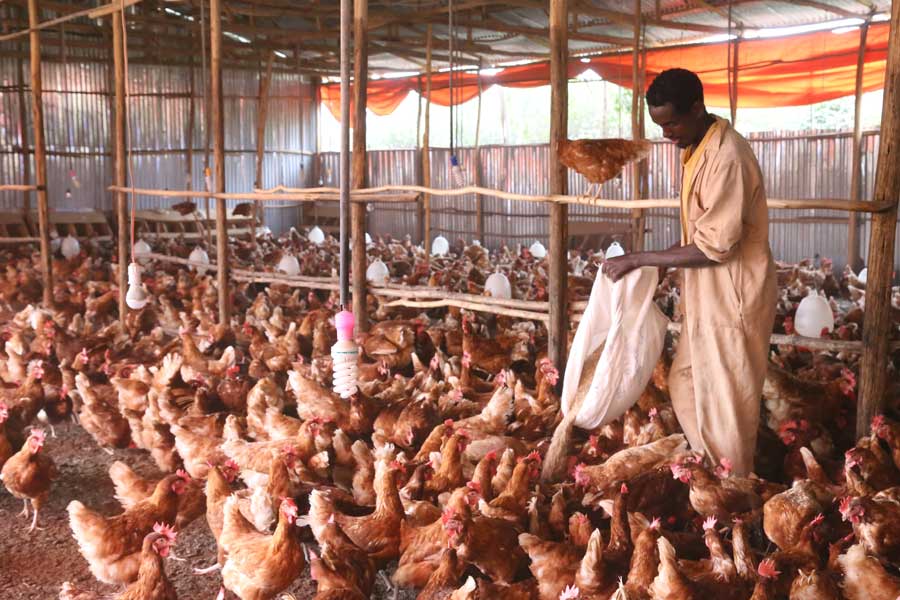
Radar | May 13,2023
For Mesfin Reday, a flower shop owner in Rehobot, Bole district, business has been choppy.
Having begun the business two years ago, he eagerly awaits Valentine's Day, graduations and wedding seasons when his flower business booms.
On a normal day, he might sell 150 stems of flowers, while on Valentine’s Day that number triples. Prices, given the higher demand, also increase from the usual three Birr to 10 Br a stem.
“We had a problem last Valentine’s Day though,” Mesfin says. “The flowers weren't stored properly while being transported, and the flowers spoiled.”
Despite the obstacles, these occasions are the best business period for the flower production industry that has been in decline for the past two years and has stagnated in the first half of this fiscal year. It is a problem that has been especially evident in the flower export business.
In the first five months of this fiscal year, cut flowers, summer flowers and roses that Ethiopia exported fetched the nation 87.37 million dollars, showing a slight decline of about a million dollars compared to the same period last fiscal year. Flowers are the fourth highest income generating commodities, behind coffee, oilseeds and gold.
The performance in the value of the exports though does not tell the full picture, having in fact shown an increase in the past two years.
Although Ethiopia has a huge potential for flower production, the industry has been in steady decline for the last two years.
The nation’s production grew by 30pc in the previous fiscal year to 713.7 million stems of cut flowers, and yet revenue grew by 11pc to 243 million dollars in the last fiscal year. Production showed only marginal changes in the five months of this year compared to the same period in the previous year.
This is despite the repeatedly touted potential of the nation in terms of horticulture. Although there is a favourable climate and two million hectares of potential land suited for flower cultivation, only around 1,600ha of land is under cultivation.
There are a number of factors that are contributing to the underperformance, including political unrest, which is disrupting supply lines and the availability of employees.
Last year's better than expected performance was a result of luck given that the industry has been seriously hit by political problems, according to Mekonen Solomon, deputy CEO of the former Ethiopian Horticulture & Agricultural Investment Authority.
“High temperature in Kenya meant that supply was affected and a shortage was created in the Dutch market, which Ethiopia took advantage of through higher prices, not more supply," Mekonen says. “This year, the country, whose biggest market is Europe, is being challenged by the Brexit crisis, as well as a political crisis in France in the form of the yellow vests movement.”
Supply also declined despite an improving weather condition, the lack of which led to a 60 million dollar decline in the Kenyan market, Africa’s largest flower exporter. Flower producers attribute the problem in Ethiopia to a continuing shortcoming in the political situation of the nation.
“To be successful in the sector there should be peace and stability, but the last two years of unrest in different parts of the country have been highly challenging,” says Emebet Tesfa, farm manager at Et-Highland Flora Plc, a company located in Sebeta, 19Km from the capital. “Filling the gap is going to take time and diversification of the market.”
Flowers are sold by a vendor on Bole Road on Valentine’s Day.
Emebet’s second point is gaining traction in the industry, with the view that the Ethiopian market is missing out in shifts taking place on the international market. This view though has its detractors, who consider it impractical and even unnecessary.
"Tulip flowers have their own favourable climatic condition,” Mekonnen says. “Once planted, flowers could be cut for the market for up to a decade from that same field, so quick shifts considering what is currently fashionable will not be cost effective.”
Yemesrach Birhanu, promotion and information system head of the Ethiopian Horticulture Producer Exporters Association, also believes that such diversification will not be the best course to take.
“International flower markets still want the rose and other flowers, not just tulips,” she says. “The sector is in need of additional land to cultivate more, which addresses gaps in performance.”
Ethiopia’s flowers are exported to the Netherlands, which takes a 72pc share, as well as Saudi Arabia, United States, Germany, Japan, Norway, United Arab Emirates, and Italy.
The horticulture sector, which includes, fruits, vegetables, flowers and herbs, employs 199,640 people across the country, a fifth of whom belong to the flower industry.
Ethiopia has 72 active flowers farms and is ranked as the second largest flower producer in Africa, next to Kenya, producing a variety of flowers including Carnations, Hypericum, Veronica, Alstromeria and Gypsophila.
Nonetheless, Ethiopia lags behind Kenya, which generates 823 million dollars in exports from the industry. Employing over 100,000 people, the flower industry contributes around one percent to its GDP. Roses, carnations and lilies are some of the major cut flowers produced in Kenya.
Experts suggest that Ethiopia can compete and meet its potential by focusing on good agricultural practices.
“Given the increased attention to green consumerism, it presents a major challenge to continue to use chemicals in the production of flowers,” says Melkamu Alemayehu (PhD), a lecturer at Bahir Dar University’s College of Agricultural & Environmental Science. “We need to introduce biological controls to gain ground in the international flower market.”
Improving the business environment, which should include minimising bureaucratic processes and developing the necessary infrastructure of the sector by increasing the availability of electric power, water and road coverage, are also necessary, he adds.
A year and a half ago the government made some policy changes to support the growers. It lowered the equity contribution of local horticulture investors to 15pc from 25pc, to get a loan from the Development Bank of Ethiopia and extended tax holiday periods and duty-free privileges for both local and international investors.
Mesfin, who is in his 30s, is growing skeptical by the day. He does not only face an industry that is producing below-par flowers but a market that is less giving than usual.
“We are getting the flowers, but the customers are not coming,” he says. “Even for a normally slow season, this is very bad.”
PUBLISHED ON
Mar 09,2019 [ VOL
19 , NO
984]

Radar | May 13,2023

Radar | Dec 04,2021

Life Matters | Apr 21,2024

Fortune News | Jan 13,2024

Commentaries | May 08,2021

Fortune News | Aug 11,2024

Radar | Jun 22,2024

Fortune News | Nov 11,2023

Fortune News | Dec 28,2019

Fortune News | Jul 25,2020

Dec 22 , 2024 . By TIZITA SHEWAFERAW
Charged with transforming colossal state-owned enterprises into modern and competitiv...

Aug 18 , 2024 . By AKSAH ITALO
Although predictable Yonas Zerihun's job in the ride-hailing service is not immune to...

Jul 28 , 2024 . By TIZITA SHEWAFERAW
Unhabitual, perhaps too many, Samuel Gebreyohannes, 38, used to occasionally enjoy a couple of beers at breakfast. However, he recently swit...

Jul 13 , 2024 . By AKSAH ITALO
Investors who rely on tractors, trucks, and field vehicles for commuting, transporting commodities, and f...

Jul 5 , 2025
Six years ago, Ethiopia was the darling of international liberal commentators. A year...

Jun 28 , 2025
Meseret Damtie, the assertive auditor general, has never been shy about naming names...

Jun 21 , 2025
A well-worn adage says, “Budget is not destiny, but it is direction.” Examining t...

Jun 14 , 2025
Yet again, the Horn of Africa is bracing for trouble. A region already frayed by wars...